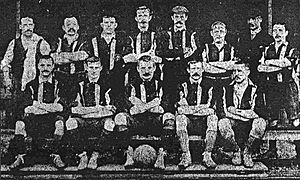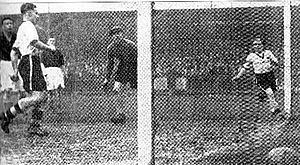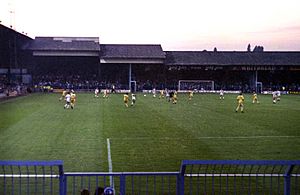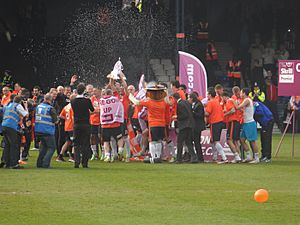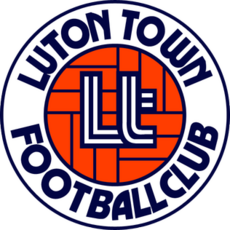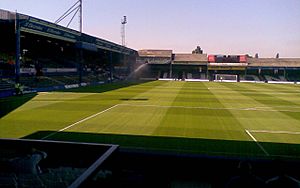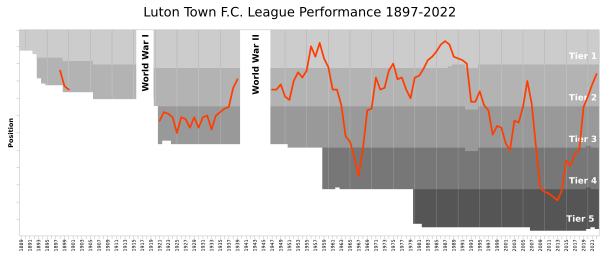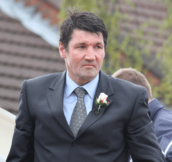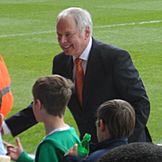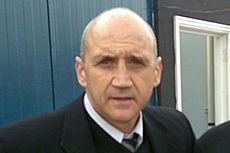Luton Town F.C. facts for kids
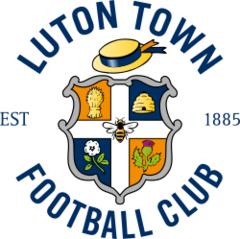 |
||||
| Full name | Luton Town Football Club | |||
|---|---|---|---|---|
| Nickname(s) | The Hatters | |||
| Founded | 11 April 1885 | |||
| Ground | Kenilworth Road | |||
| Capacity | 12,056 | |||
| Owner | Luton Town Football Club 2020 Ltd | |||
| Chairman | David Wilkinson | |||
| Manager | Matt Bloomfield | |||
| League | Championship | |||
| 2018–19 | League One, 1st of 24 (promoted) | |||
|
||||
Luton Town Football Club is a professional football team from Luton, England. They are known as "The Hatters" because of Luton's history in hat making. The club plays its home games at Kenilworth Road, a stadium they have used since 1905.
Luton Town joined the Football League in 1897 but left in 1900 due to money problems. They rejoined in 1920. The team reached the top division of English football in 1955. They even played in a major final, the 1959 FA Cup final, against Nottingham Forest.
After being relegated from the top division in 1960, Luton Town dropped down to the fourth division by 1965. But they worked their way back up, reaching the top level again by 1974.
In 1982, Luton won the Second Division title and were promoted to the First Division. A few years later, they famously beat Arsenal 3–2 in the 1988 Football League Cup final. They stayed in the top division until 1992.
Between 2007 and 2009, the club faced serious money troubles. This caused them to drop from the second tier all the way to the fifth tier of English football. In 2009, they even had 30 points taken away because of financial issues. Luton spent five seasons outside the Football League. However, they won the Conference Premier in 2014, which brought them back into the Football League.
Luton continued to climb, getting promoted from League Two in 2018 and League One in 2019. This led to their promotion to the Premier League in 2023 after winning the Championship playoffs. After one season in the Premier League, Luton faced two straight relegations. They are now playing in EFL League One.
Contents
Club History: How Luton Town Started and Grew
Forming the Club (1885–1890)
Luton Town Football Club officially started on 11 April 1885. Before this, there were other local teams like Luton Wanderers. A Wanderers player, George Deacon, had the idea of creating one big "Town" club. This new club would bring together all the best players in Luton.
A meeting was held, and despite some disagreements, the idea of forming "Luton Town Football Club" was approved. The team's first colours were pink and dark blue shirts and caps.
Luton Town started paying some players in 1890. The next year, they became the first fully professional club in southern England. They were a founding member of the Southern Football League in 1894. They finished second in their first two seasons.
The club then helped create the United League and joined the main Football League in 1897. They also moved to a new ground called Dunstable Road. However, playing in the Football League was very expensive due to long travel distances. Because of money problems, Luton returned to the Southern League in 1900.
Early 1900s: New Home and Star Players (1900–1950)
In 1905, Luton Town moved to their current home, Kenilworth Road. Bob Hawkes, a midfielder, became Luton's first player to play for the England national team in 1907.
After a tough season in 1911–12, Luton was relegated but won promotion back two years later. During World War I, the club played friendly matches. A key player from this time was Ernie Simms, a forward who scored 40 goals in the 1916–17 season.
In the 1920–21 season, Luton started wearing white and black, colours they have often used since. Before that, they wore different combinations, mostly light blue and white. In 1921, three Luton players, Louis Bookman, Allan Mathieson, and Ernie Simms, played in an international match between Ireland and England.
Luton stayed in the Third Division South until 1937. That year, they finished first and were promoted to the Second Division. During this promotion season, striker Joe Payne scored an amazing 55 goals in 39 games. The season before, he scored 10 goals in one match against Bristol Rovers, which is still a Football League record! In 1937, Eddie Parris became the first Black player to play for Luton.
Success and Challenges (1950–1992)
In the early 1950s, under manager Dally Duncan, Luton had one of its best teams. Players like Gordon Turner, the club's all-time top goalscorer, and Bob Morton, who played the most games for the club, were part of this team.
This strong team reached the top division for the first time in 1955. They also played in the FA Cup Final in 1959. However, they were relegated the next season and by 1965, they were in the fourth tier.
Luton bounced back, winning the Fourth Division championship in 1968. Two years later, they earned another promotion. In 1974, Luton Town was promoted back to the First Division, but they were relegated the very next season.
David Pleat, a former Luton player, became manager in 1978. By 1982, the team was back in the top division. Pleat's team was known for having many Black players, which was unusual at the time. Players like Ricky Hill, Brian Stein, and Emeka Nwajiobi were very important to the team's success.
In 1983, on the last day of the season, Luton needed to win against Manchester City to stay in the top league. A late goal by Raddy Antić saved the team. Manager David Pleat famously danced across the pitch in celebration.
Luton reached its highest league position ever, seventh, in 1987. A year later, managed by Ray Harford, they won the Football League Cup by beating Arsenal 3–2 in a thrilling final. They reached the League Cup Final again in 1989 but lost to Nottingham Forest.
Tough Times and Comeback (1992–2024)
Luton was relegated from the top division in 1992 and dropped to the third tier four years later. They were relegated again in 2001 but quickly won promotion back to the third tier in 2002.
In 2005, under manager Mike Newell, Luton won the third-tier Football League One championship. However, the team was then relegated twice in a row, starting in 2007. They also faced financial problems, which led to points deductions in 2008 and 2009. Despite these challenges, Luton won the Football League Trophy in 2009.
Because of the relegations, Luton played in the Conference Premier (the fifth tier) for the first time in 2009. They spent five seasons there. In 2013, Luton made history by beating Premier League club Norwich City 1–0 in the 2012–13 FA Cup. They were the first non-League team to beat a top-division side since 1989.
In 2014, under manager John Still, Luton won the Conference Premier title and returned to the Football League. They continued their rise, earning promotions from League Two in 2018 and League One in 2019. This brought them back to the Championship after 12 years.
In 2022, Luton reached the Championship play-offs but lost in the semi-finals. However, at the end of the 2022–23 season, they made it to the Championship play-offs again. They beat Sunderland in the semi-finals and then won against Coventry City in the final on penalties after a 1–1 draw. This amazing win secured their promotion to the Premier League for the very first time!
Luton won their first Premier League game on 30 September 2023, beating Everton 2–1. After a good start, their form dropped in the second half of the season. They were relegated from the Premier League in May 2024.
Recent Seasons: Back-to-Back Relegations (2024–Present)
On 3 May 2025, Luton was relegated again, this time back to EFL League One. They lost 5–3 to West Bromwich Albion on the final day of the season. Even though they had 49 points, the same as Hull City, their goal difference was worse, so they finished 22nd.
Club Identity: Nickname, Colours, and Badges
|
|
| Luton first wore white and black between 1920 and 1973. |
The club's nickname, "the Hatters," comes from Luton's long history of making hats. This trade has been important in the town since the 1600s. Fans of the club are also called Hatters.
Luton Town has used two main colour schemes: white and black, and orange, navy, and white.
- From 1920 to 1973, they mostly wore white shirts and black shorts.
- In 1973, they switched to orange, navy, and white.
- In 1979, they started playing in white shirts, shorts, and socks, with orange and navy as trim.
- From 2000 to 2008, they returned to white shirts and black shorts.
- In 2008, they brought back the white, navy, and orange colours.
- Since 2009, they have mostly worn orange shirts with white or navy shorts. For the 2015–16 season, they wore orange shirts, navy shorts, and white socks.
Luton Town has used different badges over the years.
- Their first badge in 1892 was a white eight-pointed star.
- In 1933, they first used a badge with a straw boater hat, which is a nod to the town's hat-making history.
- In 1970, they started regularly using the town's official crest.
- In 1973, a new badge was introduced with a stylised orange football and the letters "Lt".
- In 1987, they went back to a design based on the town's emblem.
- A "rainbow" badge was used from 1994 to 2005.
- Since 2009, the badge has featured the town crest with orange colours to match the team's kit.
The club also released songs, like "Hatters, Hatters" in 1974 and "We're Luton Town" in 1982.
Shirt Sponsors
The first sponsor on a Luton Town shirt was Tricentrol, a local car company, from 1980 to 1982.
Here is a list of some of Luton Town's main shirt sponsors:
- 1982–1990: Bedford Trucks
- 1990–1991: Vauxhall
- 1991–1999: Universal Salvage Auctions
- 1999–2003: SKF
- 2003–2005: Travel Extras
- 2005–2008: Electrolux
- 2008–2009: Carbrini Sportswear
- 2009–2015: EasyJet and NICEIC
- 2015–2016: Barnfield College and NICEIC
- 2016–2018: NICEIC and SsangYong Motor UK
- 2018–2019: Indigo Residential (home), Star Platforms (away), Northern Gas & Power (third)
- 2019–2020: Indigo Residential (home), Star Platforms (away), Ryebridge Construction (third)
- 2020–2022: JB Developments (home), Star Platforms (away), Ryebridge Construction (third)
- 2022–2023: Utilita (home), Star Platforms (away), Ryebridge Construction (third), The Wood Veneer Hub (training)
- 2023–2024: Utilita (main), FREE NOW (sleeve), TUI (training)
Stadium: Kenilworth Road and Future Plans
Luton Town's first ground was at Dallow Lane. In 1905, the club moved to its current home, Kenilworth Road.
The stadium can hold 11,600 people and is in the Bury Park area of Luton. It's named after the road next to it. The Main Stand burned down in 1921 and was rebuilt. In 1985, the grass pitch was replaced with an artificial one, which was not very popular.
After a serious incident with fan trouble in 1985, the club's chairman introduced rules that banned visiting supporters for a while. Home fans also needed membership cards. The stadium was converted to all-seater in 1986. Away fans were allowed back in 1990, and a grass pitch returned in 1991.
New Stadium Plans
Luton Town has wanted a new stadium for a long time because Kenilworth Road is small and hard to expand. They have tried to move several times.
In April 2016, the club announced plans to build a new 17,500-seat stadium at the Power Court site in central Luton. This plan was approved in January 2019. The club later updated the plans, aiming for a 23,000-seat stadium.
In April 2025, a Turkish company called Limak International was chosen to build the new stadium. Construction is set to begin in summer 2025. The new 25,000-capacity stadium is expected to be ready for the 2028–29 season.
Supporters and Rivalries
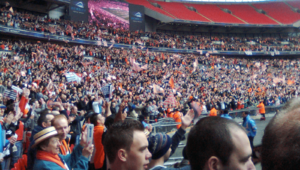
Luton Town has a strong fan base. In the 2014–15 season, they had the second-highest average home attendance in League Two. Even when they were in the fifth tier in 2013–14, their average attendance was much higher than other clubs in that league.
A group called Trust in Luton owns shares in the club and has a say in important decisions. This group can even stop changes to the club's name, nickname, colours, or badge.
Luton Town fans have a big rivalry with Hertfordshire-based club Watford. While Watford was ranked higher for many years, Luton still has a better overall record in games between the two clubs. Luton has won 55 matches, Watford has won 38, and there have been 29 draws. Luton fans also have a friendly relationship with the Dutch team Go Ahead Eagles.
The club has a mascot named Happy Harry, a smiling man wearing a straw boater hat. In 2014, Luton and Morecambe F.C. started awarding the "Eric Morecambe Trophy" to the winner of their matches.
Records and Statistics
- The player with the most appearances for Luton is Bob Morton, who played 562 times.
- Six players have scored over 100 goals for Luton: Gordon Turner, Andy Rennie, Brian Stein, Ernie Simms, Herbert Moody, and Steve Howard.
- Robert Hawkes was the first Luton player to play for the England national team in 1907.
- The player with the most international appearances while at Luton is Mal Donaghy, who played 58 times for Northern Ireland.
- Joe Payne holds the Football League record for most goals in a single game, scoring 10 goals against Bristol Rovers in 1936.
- Luton's biggest win was 15–0 against Great Yarmouth Town in the FA Cup in 1914.
- Their heaviest loss was 9–0 against Small Heath in 1898.
- The highest attendance at a home game was 30,069 against Blackpool in the FA Cup in 1959.
- The highest transfer fee Luton Town has received for a player was for James Justin, who joined Leicester City in 2019.
- The most expensive player Luton Town has bought was Ryan Giles, who joined from Wolverhampton Wanderers in 2023 for £5 million.
- The youngest player to play for Luton Town's first team is Connor Tomlinson, who was 15 years and 199 days old when he played in 2016.
Players
Current Squad
|
|
Youth Teams
Luton Town has a Development Squad for senior players, youth team scholars, and trialists. They also have an Under-18 team. The club's youth program includes Soccer Centres, Centres of Excellence, and an academy for younger players.
Backroom Staff
- As of 24 October 2021
Club Leadership
- Chairman: David Wilkinson
- Chief Executive Officer: Gary Sweet
- Directors: Paul Ballantyne, Stephen Browne, Bob Curson, Mike Herrick, Rob Stringer
Coaching and Support Staff
- Manager: Matt Bloomfield
- Assistant Manager: Richard Thomas
- First-team Coaches: Lee Harrison and Kevin Foley
- Head of Goalkeeping: Kevin Pilkington
- Chief Recruitment Officer: Mick Harford
- Head of Sports Science: Josh Hornby
- Head of Coaching and Player Development/Under 21s Lead Coach: Alex Lawless
- Player Recruitment Manager: Yousuf Sajjad
- Chief Scout: Marc Tracy
- Head of Medical: Danny Murphy
- Physiotherapist: Chris Phillips
- Therapist and Kitman: Darren Cook
- Academy and Development Managers: Paul Benson and Wayne Turner
- Under 18s Head Coach: Joe Deeney
- Head of Academy Coaching: Ben Strevens
Managers
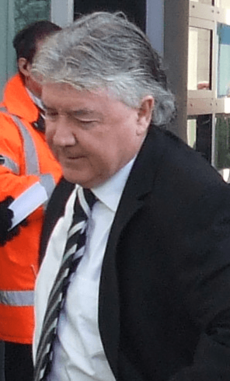
Here are some of Luton Town's managers who were in charge for at least 50 competitive matches:
| Name | Nation | From | To | Matches | Won | Drawn | Lost | Win % |
|---|---|---|---|---|---|---|---|---|
| John McCartney | 14 September 1927 | 21 December 1929 | 151 | 57 | 38 | 56 | 37.7 | |
| George Kay | 23 December 1929 | 13 May 1931 | 71 | 29 | 16 | 26 | 40.8 | |
| Harold Wightman | 1 June 1931 | 9 October 1935 | 198 | 85 | 49 | 64 | 42.9 | |
| Ned Liddell | 13 August 1936 | 26 February 1938 | 79 | 42 | 11 | 26 | 53.2 | |
| Dally Duncan | 13 June 1947 | 16 October 1958 | 503 | 192 | 133 | 178 | 38.2 | |
| Sam Bartram | 18 July 1960 | 14 June 1962 | 95 | 35 | 18 | 42 | 36.8 | |
| Bill Harvey | 24 July 1962 | 21 November 1964 | 121 | 37 | 26 | 58 | 30.6 | |
| George Martin | 16 February 1965 | 3 November 1966 | 82 | 34 | 16 | 32 | 41.5 | |
| Allan Brown | 4 November 1966 | 17 December 1968 | 111 | 56 | 24 | 31 | 50.5 | |
| Alec Stock | 20 December 1968 | 27 April 1972 | 172 | 71 | 56 | 45 | 41.3 | |
| Harry Haslam | 4 May 1972 | 23 January 1978 | 275 | 110 | 69 | 96 | 40.0 | |
| David Pleat | 24 January 1978 | 16 May 1986 | 393 | 158 | 108 | 127 | 40.2 | |
| Ray Harford | 16 June 1987 | 3 January 1990 | 133 | 51 | 34 | 48 | 38.3 | |
| Jim Ryan | 11 January 1990 | 13 May 1991 | 63 | 18 | 16 | 29 | 28.6 | |
| David Pleat | 7 June 1991 | 11 June 1995 | 207 | 55 | 70 | 82 | 26.6 | |
| Lennie Lawrence | 21 December 1995 | 4 July 2000 | 250 | 90 | 66 | 94 | 36.0 | |
| Joe Kinnear | 8 February 2001 | 23 May 2003 | 122 | 56 | 28 | 38 | 45.9 | |
| Mike Newell | 23 June 2003 | 15 March 2007 | 200 | 83 | 49 | 68 | 41.5 | |
| Mick Harford | 16 January 2008 | 1 October 2009 | 91 | 25 | 29 | 37 | 27.5 | |
| Richard Money | 30 October 2009 | 28 March 2011 | 83 | 45 | 21 | 17 | 54.2 | |
| Gary Brabin | 28 March 2011 | 31 March 2012 | 62 | 29 | 22 | 11 | 46.8 | |
| John Still | 26 February 2013 | 17 December 2015 | 148 | 69 | 38 | 41 | 46.6 | |
| Nathan Jones | 6 January 2016 | 9 January 2019 | 170 | 87 | 46 | 37 | 51.2 | |
| Nathan Jones | 28 May 2020 | 10 November 2022 | 133 | 54 | 37 | 42 | 40.6 | |
| Rob Edwards | 17 November 2022 | 9 January 2025 | 76 | 25 | 20 | 31 | 32.9 |
Honours: Trophies and Achievements
- Luton Town has won many awards and trophies. Here are some of their most important ones:
League Titles
- Second Division / Championship (Level 2)
- Champions: 1981–82
- Runners-up: 1954–55, 1973–74
- Play-off Winners: 2023
- Third Division South / Third Division / League One (Level 3)
- Champions: 1936–37 (South), 2004–05, 2018–19
- Runners-up: 1935–36 (South), 1969–70
- Fourth Division / Third Division / League Two (Level 4)
- Champions: 1967–68
- Runners-up: 2001–02, 2017–18
- Conference Premier (Level 5)
- Champions: 2013–14
Cup Wins
- FA Cup
- Runners-up: 1958–59
- Football League Cup
- Winners: 1987–88
- Runners-up: 1988–89
- Football League Trophy
- Winners: 2008–09
- Full Members' Cup
- Runners-up: 1987–88
See also
 In Spanish: Luton Town Football Club para niños
In Spanish: Luton Town Football Club para niños


